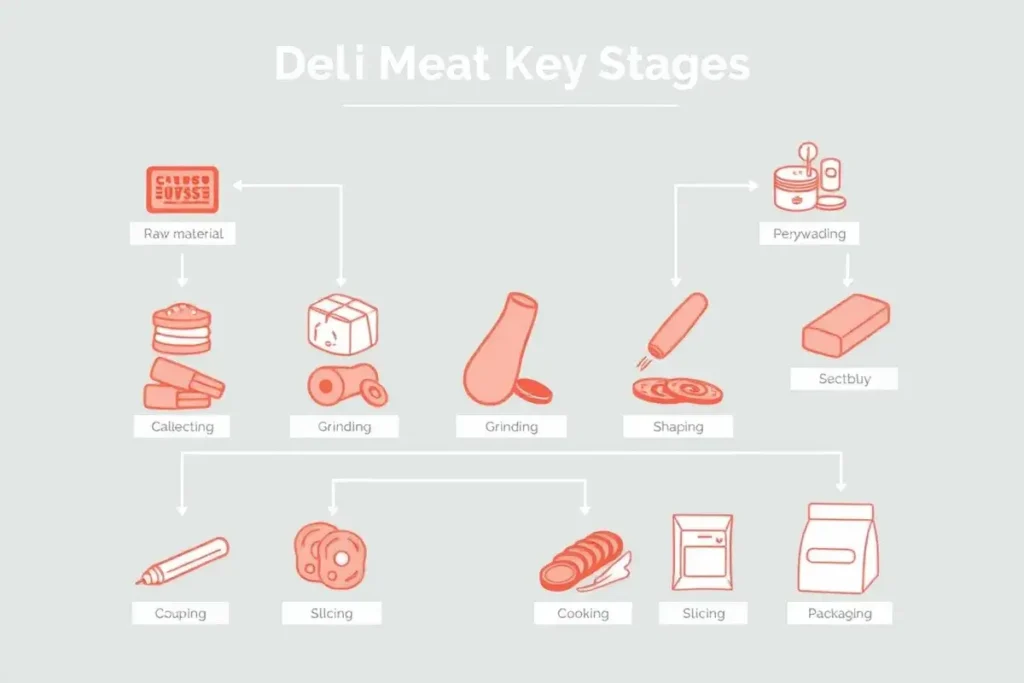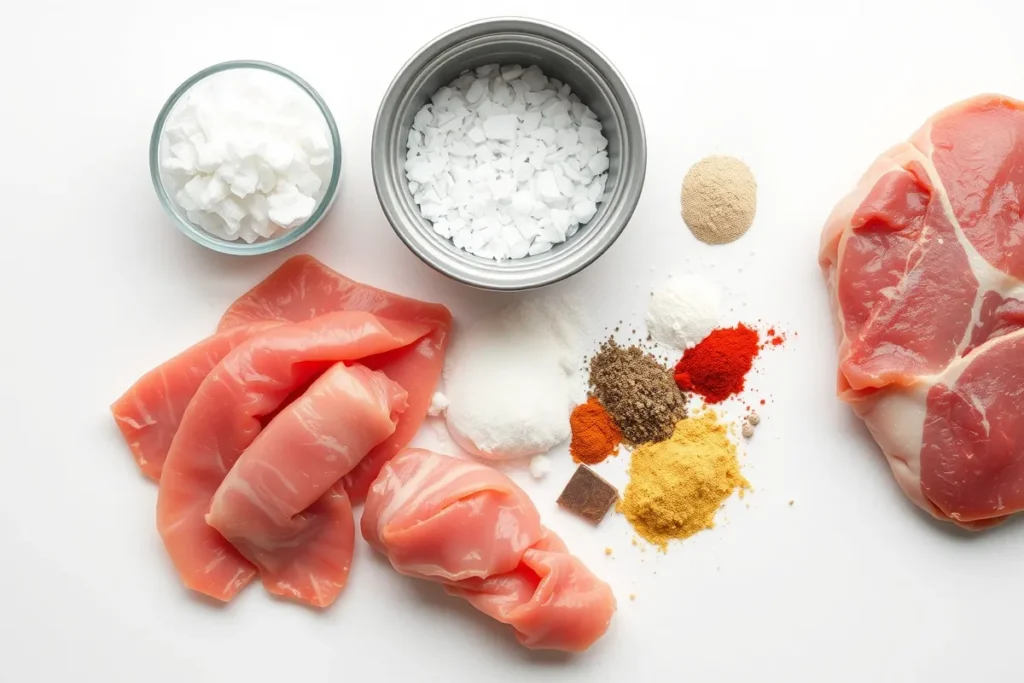Have you ever wondered how do they make deli meat? This article explores the fascinating journey of deli meat, from raw materials to sliced product, and details what you need to know.
Understanding Deli Meat Basics
Making deli meat is a mix of skill and science. It involves careful steps to ensure the final product is safe, tasty, and consistent. From choosing raw materials to final packaging, every detail matters. Understanding the basics of how is deli meat made helps us see the variety available.
Raw Material Choice for Deli Meat
The making of deli meat starts with selecting good raw materials. How is deli meat made also relies on the meat’s quality. This includes cuts of beef, pork, turkey, or chicken. Additionally, other items such as salt, spices, and curing items are key. These are picked based on what type of deli meat is being made.
The Deli Meat Curing Stage
After choosing materials, the curing process begins. Curing is very important in deli meat making. It uses salt, nitrates, or nitrites to keep the meat fresh. Furthermore, curing affects the flavor and texture. Therefore, this step in the deli meat manufacturing process needs to be precise.
Key Steps in the Deli Meat Making Process
Several steps are part of how do they make deli meat after curing. These steps change raw meat into the deli slices we see at the market.

Grinding and Mixing
The first main step includes grinding and mixing. Here, the cured meat is ground into smaller bits. Then, spices, seasonings, and other flavors are mixed with the meat. Commercial meat production facilities use large equipment to ensure a smooth mix.
Shaping the Deli Meat
Shaping is another key step in the deli meat making. In this stage, the ground and mixed meat is formed into its final shape. Large casings, molds, or special machines are used to shape the sliced meat. Steps in making sliced meats also affect how it looks.
Cooking and Smoking
After shaping, the sliced meat is cooked and often smoked. Cooking ensures the meat is safe to eat and helps its texture. Smoking, on the other hand, adds a unique smell. For example, how is ham made, uses this to get its taste. This step changes the traits of different deli meats.

Cooling and Slicing
After cooking, the sliced meat is cooled. This allows it to get firm before slicing. Then, industrial meat slicing machines ensure each piece is even. Proper cooling helps keep the product fresh and ready for easy slicing.
Packaging
The final step of how is deli meat made is packaging. Packaging is key for keeping the product fresh and clean. Vacuum sealing or special gas packaging are often used. These methods help deli meats stay good longer.
Different Kinds of Deli Meat and How They Are Made
There are many types of deli meats, each with its own making process. Understanding how do they make deli meat helps you appreciate the variety available.
How Ham Is Made
How is ham made? This sliced meat uses cured pork legs. The process includes brining, cooking, and sometimes smoking. The end result is a tasty product with a special flavor. Ham is very common in sandwiches and other dishes.
How Turkey Deli Meat is Made
Turkey is another popular sliced meat. How is turkey meat processed? It involves brining and roasting turkey breasts or parts, then slicing. Turkey is often a leaner choice, making it liked by health-focused people.
Making Bologna
Bologna is a cooked sausage, also a common sliced meat. What is bologna made of includes mixing ground beef or pork with spices, then cooking and smoking it. Bologna also has a very smooth texture.
Salami‘s Unique Process
What’s the process for making salami? This sliced meat is a mix of cured and fermented meats, mostly pork. The process uses many spices for its flavor. The meat is then fermented for a long time. This gives salami its special taste.
Crafting Roast Beef
How do they make roast beef for sandwiches? Roasting beef involves searing and roasting beef cuts until they are cooked just right. Then, the meat is thinly sliced for use in sandwiches. The roast beef process may include many seasonings.
Key Things That Affect Deli Meat Quality
Several things impact the quality of sliced meat. These are kept in mind during the deli meat manufacturing process to make sure of consistent and great products.
Quality of Ingredients
The quality of raw ingredients is essential for great sliced meat. Good meat, spices, and curing items lead to a better product. Therefore, using only top-tier items is essential to ensure great taste and texture.
Precision in Curing
Proper curing is a critical part of the process. It impacts both the safety and taste of sliced meat. Thus, keeping track of temps and curing times is very important. The correct process of commercial meat production ensures a safe item.
Maintaining Cleanliness
The best hygiene is key in how do they make sliced meat. Clean equipment prevents contamination. Accordingly, this protects consumers by providing safe products.
Temperature Control
Temperature control is very important in making good sliced meat. Keeping a cold temp during the entire process is essential. Correct temp control stops the growth of bad bacteria.
Proper Equipment Use
Using advanced equipment improves the process of how do they make deli meat. Therefore, good slicing and packaging machines improve consistency. Regular upkeep ensures each item is made to the highest standard.
The Role of Additives and Preservatives
Additives and preservatives are key in sliced meat production. They help to keep the product fresh, tasting great, and safe. Understanding processed meat ingredients is also important.

Why Use Additives in Deli Meat?
Additives serve several functions. They improve the flavor, texture, and color of sliced meat. Also, they enhance how these products appeal to consumers. Moreover, they also help sliced meat stay good for longer.
Types of Preservatives in Deli Meat
Preservatives stop bad bacteria from growing. Salt, nitrates, and nitrites are common preservatives. They protect against foodborne illnesses. Also, preservatives help sliced meat last longer.
Concerns About Artificial Preservatives
The use of artificial preservatives is a concern for many people. Some are worried about health effects. However, most preservatives used are checked by the government and are approved for safety.
Health Issues with Deli Meat
The eating of sliced meat is often talked about. It is key to look at both the good and bad sides. Therefore, understanding meat processing methods helps people choose their diet well.
Nutrients in Deli Meat
sliced meat can have protein and other essential vitamins. For example, turkey is a leaner option. However, ham, roast beef, and salami tend to have more fat and sodium. The amount of nutrition varies greatly by type.
Possible Health Problems
There are some health concerns linked to sliced meat. These include high sodium and artificial additives and preservatives. Processed meats often contain fat. Too much sodium and preservatives can be a health risk for some.
Making Informed Choices
Choosing lower-sodium, leaner sliced meat is a good step. Eating deli meats only sometimes is important for a balanced diet. Therefore, carefully choosing sliced meat reduces any risks.
Trends and New Ideas in Deli Meat Making
The deli meat world is always changing. It changes to meet what consumers want in terms of healthier and more sustainable items.
Lower Sodium Choices
More brands focus on lowering sodium levels. This is a response to people wanting to eat healthier. Therefore, many companies now sell sliced meat with less sodium.
Clean Label Ingredients
The demand for clean label products is growing. Consumers want to know exactly what is in their food. Also, sliced meat companies are using more natural ingredients.
Sustainable Practices
The environmental impact of meat processing is a growing worry. Companies are choosing more recyclable packaging. Furthermore, some also use more sustainable ways to make meat.
Common Deli Meats and Their Attributes
| Deli Meat Type | Primary Meat | How It’s Made | Main Flavor Notes |
| Ham | Pork | Cured, Cooked, Smoked | Savory, Slightly Sweet |
| Turkey | Turkey | Brined, Roasted | Mild, Savory |
| Bologna | Beef or Pork | Ground, Cooked, Smoked | Savory, Spiced |
| Salami | Pork | Cured, Fermented, Dried | Tangy, Bold |
| Roast Beef | Beef | Roasted | Savory, Rich |
Additives and What They Do in Deli Meat
| Additive/Preservative | Purpose | How it is Used |
| Sodium Nitrite | Curing, Preservation | Stops bad bacteria, adds color |
| Sodium Nitrate | Curing, Preservation | Keeps it good for longer, improves flavor |
| Salt | Preservation, Flavoring | Dehydrates food, adds flavor |
| Spices | Flavor | Enhances taste and scent |
The Evolution of Deli Meat Making
The ways that how do they make sliced meat have changed over time. Technological advances have greatly improved the process. Consequently, it’s now more efficient, safer, and makes higher-quality products.
Old Methods to New Ways
Historically, sliced meats were made using basic methods, such as salt curing and smoking. However, modern techniques use better tools and ways, such as vacuum tumbling and high-pressure processing (HPP). These improvements enhance both taste and safety.
Automation in Meat Work
Automation has changed the sliced meat industry a lot. Machines now do jobs that people used to do by hand. This boosts consistency and speed in the deli meat manufacturing process and cuts down on errors.
New Tech Ideas
New tech ideas include advanced slicing and packaging. Also, modern systems to control temperature now help to ensure food safety. These new technologies improve how do they make deli meat.
Impact of Research
Research has played a key role in progress. Better curing methods and better meat science are the result. Also, they have created better products and making techniques. Furthermore, these changes now give consumers better options.
Sustainability in Deli Meat Making
Sustainability is very important for all food production. The Sliced meats industry is responding to the need for more eco-friendly methods.
Eco-Friendly Packaging
Recyclable and biodegradable stuff is more and more used for Sliced meats packaging. Companies are moving away from plastics that are used only once. Therefore, this reduces the environmental cost of sliced meat.
Less Water Use
Water is key in meat processing. Thus, the industry is using tech to reduce how much water they use. Better water recycling and treatment are being used. As a result, this leads to more sustainable production.
Good Meat Sourcing
Responsible sourcing is becoming very common. This includes choosing suppliers that use good practices. Also, certifications such as Fair Trade are now prioritized.
Waste Reduction
Strategies to lower waste are essential. This includes better management of by-products. Companies find new ways to use all materials fully. This reduces waste and boosts how efficiently how do they make deli meat.
What Makes Deli Meat Appealing
The look, feel, and taste of sliced meats are key to its appeal. Therefore, these are managed carefully during production.
Texture
The texture of sliced meat greatly impacts what people think of it. Techniques like tumbling make it tender and improve its mouthfeel.
The Smell
The aroma is also key. Smoking and using aromatic spices can enhance appeal. A good smell greatly adds to the overall enjoyment.
Flavor
The taste is very important. The balance between salty, sweet, and savory must be perfect. The curing process and choices in seasoning also have a big effect on flavor.
How It Looks
Presentation greatly helps how consumers view sliced meat. Uniform slicing, attractive displays, and clear packaging make it more appealing.
How Deli Meat is Used
Deli meat is very versatile and can be used in many different ways.
Deli Meat in Sandwiches
Deli meat is a key ingredient for sandwiches. It adds flavor to endless sandwich variations. Moreover, from simple turkey and cheese to Italian prosciutto, there are many options.

Using Deli Meat in Salads
Deli meat is also great in salads. It adds protein and makes the salads more satisfying. Also, chopped sliced meat can be served with cheeses, fruits, or crackers.
Deli Meat in Cooking
Deli meat can be an ingredient in cooked dishes. For example, chefs use ham in casseroles and breakfast dishes. Also, salami can improve pizza and pasta. Therefore, sliced meat is easy to use in many meals.
Deli Meat Pairings
Correctly pairing sliced meat enhances the taste of everything. Dry white wine, for instance, compliments turkey or prosciutto. Also, cucumber and tomatoes add a refreshing taste to rich deli meats.
You May Also Like:
- How is Chicken Breast Deli Meat Made? A Complete Guide
- How Do They Make Sliced Chicken Breast? A Step-by-Step Guide
- Is Chicken Breast Lunch Meat Healthy? Discover 8 Hidden Benefits
The Shopper’s Role in Deli Meat Choice
Consumers are important in choosing sliced meat. Being careful when shopping helps to shape the industry.
Reading Labels
Reading labels is essential when picking deli meats. Specifically, check sodium content, additives, and the type of meat. This will help you pick the best option.
Knowing Your Tastes
Understanding your dietary needs is important. Pick deli meats based on what you like. If watching your carbs, limiting carbohydrates is a good idea.
Supporting Ethical Brands
Picking brands that use sustainable and good practices is key. Furthermore, support companies that use responsible sourcing of materials. Consumers can lead companies towards good practices.
Proper Storage
Proper storage makes sliced meat last longer. Specifically, keep it cold right after buying. Keep it sealed to stop any germs from entering.
Important Factors When Picking Deli Meat
| Factor | What It Means | Example |
| Sodium Content | Amount of salt per serving | Select lower salt versions to lower salt intake. |
| Additives | Things added like colors or flavors | Choose “clean label” products with less artificial items. |
| Meat Source | Type of meat used | Select leaner turkey or chicken for less fat. |
| Production Methods | Ways of making it like curing or smoking | Support brands that prioritize sustainability. |
What Deli Meats are Best for
| Deli Meat | Best Use | Good Pairings |
| Ham | Sandwiches, breakfast, casseroles | Cheese, mustard, whole grain bread |
| Turkey | Salads, wraps, sandwiches | Avocado, lettuce, tomatoes |
| Bologna | Sandwiches, fried, appetizers | Cheese, crackers, pickles |
| Salami | Appetizers, pizza, pasta | Olives, cheese, red wine |
| Roast Beef | Sandwiches, wraps, salads | Horseradish, lettuce, onion |
The Future of Deli Meat
The deli meat industry is constantly changing. Consumers’ needs change, and the industry has to adapt to new tech. In the future, there may be more options to meet different diet needs. Additionally, we may see a greater focus on sustainability and health.
Deli Meat Choices Just For You
Future trends could make personalized sliced meat possible. People might soon pick their flavors and nutritional content, leading to a more customized experience.
Plant-Based Options
The growing popularity of plant-based proteins has already made an impact on the sliced meat industry. Also, we can expect more types of plant-based “deli meats.” Therefore, these offer a healthier alternative for people who want to eat less meat.
Clear Methods
Consumers are demanding better transparency. Thus, companies need to be clearer about their methods. They also need to share information with the people who buy from them.
New Tech
New tech like 3D printing might impact sliced meat in the future. This could create custom shapes and textures. Furthermore, it would also allow for a greater variety of culinary creations.
Frequently Asked Questions (FAQs)
Is deli meat still processed meat?
Yes, deli meat is considered processed meat. This means that producers alter it through curing, smoking, or adding preservatives.
What deli meats to avoid?
It’s best to limit deli meats that are high in sodium and artificial additives. This includes bologna, salami, and some hams. Lean options like turkey and chicken are better choices.
Is any deli meat healthy?
Some deli meats can be part of a healthy diet. Lean options like turkey and chicken are protein-rich and low in fat. Eating these in small amounts is the best.
Is there still a Listeria outbreak in deli meat?
Listeria outbreaks in sliced meat do occur, however, they are less common now. Proper packaging and safety rules have reduced the risk. Therefore, always buy products from trusted brands.

